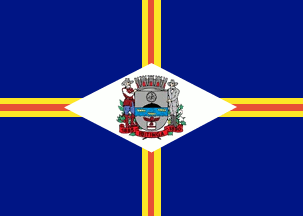 image by Dirk Schönberger,
8 November 2012
image by Dirk Schönberger,
8 November 2012Source: http://www.ibitinga.sp.gov.br/novoportal/principal.php?go=15

Last modified: 2012-12-15 by ian macdonald
Keywords: sao paulo | ibitinga |
Links: FOTW homepage |
search |
disclaimer and copyright |
write us |
mirrors
 image by Dirk Schönberger,
8 November 2012
image by Dirk Schönberger,
8 November 2012
Source:
http://www.ibitinga.sp.gov.br/novoportal/principal.php?go=15
A dark blue flag with a narrow red upright cross, bordered yellow, and the municipal arms in the centre in a white lozenge.
Official website at
http://www.ibitinga.sp.gov.br
Dirk Schönberger,
8 November 2012
Ibitinga was founded by Miguel Landim, a colonist from Minas Gerais, who built in 1860 the Agua Quente chapel. On 31 October 1870, Landim and his wife Ana Custódio de Jesus offered to the Church the land where the town of Ibitinga would emerge. The name of the town comes from two Tupi-Guarani words, "ibi", "the soil", and "tinga", "white". The district of Ibitinga was established in 1885 by Provincial Law No. 105. The municipality of Ibitinga was established on 4 July 1890 by Provincial Law No. 66. Proclaimed an Area of Protected Environment in 1987, Ibitinga was granted the title of Tourist Resort in 1992 by State Law no. 8,199. Ibitinga is recognized as the National Capital of Embroidery, an industry that involves 2,100 commercial and industrial companies and employs, directly or indirectly, 35,000 people - that is, 90% of the active population in the municipality.
The flag, coat of arms and anthem are listed, without further
description, as the municipal symbols of Ibitinga in Article 3 of the
Municipal Constitution, last amended on 8 July 2008.
http://www.ibitinga.sp.gov.br/novoportal/downloads/lei_organica.pdf
- Municipal Constitution
The flag, designed by Arcinoé Peixoto de Faria, is blue with a yellow- red-yellow cross. In the middle is placed a white lozenge charged with the municipal coat of arms.
The design follows the Portuguese heraldic tradition, whose canons and rules were inherited by Brazilian heraldry, including the prescription of divisions in eight, six or four parts by a cross, symbolizing here the Christian faith of the inhabitants of Ibitinga. The coat of arms placed in the middle of the flag represents the municipal government, while the white lozenge represents the town seat of the municipality. The stripes represent the municipal power spreading to the whole municipal territory. The quarters of the flag represent the rural estates part of the municipality. The proportions of the flag should be the same as for the national flag, that is 14 units x 20 units.
The coat of arms was designed by Afonso d'Escragnolle Taunay*, and modernized by Arcinoé Peixoto de Faria. "Argent a fess wavy azure charged with three boats or, in chief a rock sable issuant from the fess ensigned with a Christ's monogram orled by a crown of thorns all of the same, in base an escutcheon argent a fess gules in chief a lion's head of the same, the escutcheon surmounted by an eagle displayed of the same. The shield surmounted by an eight- towered mural crown argent ports gules. The shield supported dexter by a pioneer in front of a coffee branch and sinister by a landlord in front of a plant of cotton. Below the shield a scroll gules inscribed with the toponym 'IBITINGA' surrounded by the years '1885' and '1890' all sable."
The classical Flemish-Iberic shield, belonging to the style inherited by Brazilian heraldry, evokes the colonizers and builders of the nation. The eight-towered mural crown stands for a town with the rank of seat of "comarca". Argent is a symbol of peace, friendship, work, prosperity, purity and religious feeling. The fess wavy represents river Tietê. Azure is a symbol of justice, nobleness, perseverance, zeal and loyalty. The boats represent the pioneer's river expeditions, locally known as "monções", which used to moor in Porto das Monções, located on the today's municipal territory. Or is a symbol of glory, wealth, splendour, greatness and sovereignty. The rock emerging from the river is the historical statue of the patron saint of Ibitinga, brought from Itapura. The Christ's monogram surrounded by a crown of thorns represents the patron saint of the town. Sable is a symbol of prudence, wisdom, moderation, dedication and science. The escutcheon represents the arms of the Landim family, as a tribute to Miguel Landim, considered as the founder of the town. The supporters represent the development and settlement of the region. The dates on the scroll represents the establishment of the district and of the municipality of Ibitinga, respectively. Gules is a symbol of patriotic love, audacity, intrepidity, courage and valiance.
*Afonso d'Escragnolle Taunay (1876-1958) was a genealogist,
lexicographer and historian, noted for his studies on the São Paulo
pioneers ("História geral das bandeiras paulistas", 11 volumes,
1924-1950) and coffee cultivation in Brazil ("História do café no
Brasil", 11 volumes, 1929-1941). He was elected in 1929 at the
Brazilian Academy of Letters.
http://www.academia.org.br/abl/cgi/cgilua.exe/sys/start.htm?sid=88 -
Website of the Brazilian Academy of Letters
Ivan Sache, 10 November 2012